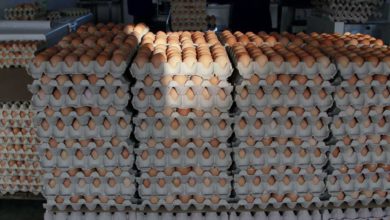
- The National Bureau of Statistics on Wednesday said that the composite food index rose by 20.30 per cent in August compared to 21.03 per cent recorded in July 2021. This implies that that food inflation continued to rise in August, however, at a slower pace than July. In recent times, Nigeria has been faced with the huge challenge of unbearable hike in prices of food commodities. The country has also found itself in serious food uptight condition and this has been a great concern for most people, especially the poor and vulnerable.
This implies that that food inflation continued to rise in August, however, at a slower pace than July.
In recent times, Nigeria has been faced with the huge challenge of unbearable hike in prices of food commodities.
The country has also found itself in serious food uptight condition and this has been a great concern for most people, especially the poor and vulnerable.
The skyrocketing food prices in major cities across the country have had huge effects on the budget of households and firms.
Prices of foodstuff such as yams, beans, rice including pepper, seasoning and others have gone on the roof.
Also, the cost of bread, bottled water, soft drinks and many other edibles have increased.
The NBS confirmed this in its report on Wednesday when it stated that the rise in food inflation in August was driven by increase in the prices of bread and cereals, milk, cheese and egg, oils and fats, potatoes, yam and other tuber, meat and coffee, tea and cocoa.
The report noted that on a month-on-month basis, the food sub-index increased by 1.06 per cent in August, up by 0.20 per cent points from 0.86 per cent recorded in July.
“The average annual rate of change of the food sub-index for the 12-month period ending August 2021 over the previous 12-month average was 20.50 per cent, 0.34 per cent points from the average annual rate of change recorded in July 2021 (20.16) per cent,” it added.
A cursory look at the food inflation rate between January and August shows fluctuation in trends.
In January, for instance, food inflation rose to 20.57 per cent, compared to 19.56 per cent in December 2020 and was as high as 22.95 per cent in March.
However, in April, food inflation stood at 22.72 per cent and continued to rise at a decreasing level until August.
Further analysis of the latest CPI report revealed that on YoY basis, food inflation was highest in certain states such as Kogi (28.76 per cent), Oyo (23.69 per cent) and Gombe (22.37 per cent), while River (17.69 per cent), Edo (17.26 per cent) and Bauchi (17.24 per cent) recorded the slowest rise.
“On month on month basis however, August 2021 food inflation was highest in Ekiti (2.70 per cent), Abuja (2.62 per cent) and Akwa Ibom (2.50 per cent), while Lagos (0.04 per cent) and Edo (0.08 per cent) recorded the slowest rise with Kaduna recording price deflation or negative inflation (general decrease in the general price level of food or a negative food inflation rate),” the report stated.
The Consumer Price Index which measures inflation rate fell to 17.01 per cent in August.
According to the latest CPI report, this rate is 0.37 per cent points lower than the 17.38 per cent recorded in July this year.
This is the fifth consecutive month that the country’s inflation rate will be trending downward since March this year.
Inflation dropped from 18.17 per cent in March to 18.12 per cent in April before dropping further to 17.93 per cent, 17.75 per cent and 17.38 per cent in the months of May, June and July respectively.
The NBS said that on a month-on-month basis, the headline index increased by 1.02 per cent in August 2021, adding that this is 0.09 per cent rate higher than the 0.93 per cent recorded in July 2021.
The report stated, “The consumer price index, which measures inflation increased by 17.01 per cent (year-on-year) in August 2021.
“This is 0.37 per cent points lower than the rate recorded in July 2021 (17.38) per cent.”
Speaking on the development, experts called on the government to address the issue of food insecurity in the country.
They said by boosting food production, food inflation which constitutes a major component of the headline inflation will decline significantly.
Managing Director, Cowry Asset Management Limited, Mr Johnson Chukwu, a financial analyst, explained that the figures were an actual representation of the market situation.
He said, “There is actually no disparity between the report and the reality in the market. The problem stems from understanding.
“We have to understand that the 17.01 per cent inflation rate recorded in August doesn’t represent a disinflation in prices of products but shows from August 2020 to last month inflation has risen by this percentage which is lower that the inflation rate that was recorded between July of last year and that of this year.
“What Nigerians have to understand is that the prices of goods and services are still increasing at the rate at which the inflation is increasing; therefore, the cost of products will still be high at the market.
“When they say inflation is moderating, it means that prices are rising at a slower pace.
“Simply put, what the latest report implies is that if a particular product sold for N1000 last year August, as at August this year, it sold for N1000 plus the 17.01 per cent.”
Beyond improving food production, he called on the government to work towards stabilising the naira to moderate import inflation.
Another expert and the Chief Executive Officer, SD&D Capital Investment, Gbolade Idakolo, said that the current inflation rate was fueled by high foreign exchange rate which has led to a hike in the price of goods and services.
He also said that due to the government’s continuous borrowing, most of the revenue meant to develop the economy was used to service debt, thus leaving little or no revenue for developing the real sector.
The development of the real sector, he said, can help to further lessen inflationary pressures.
“High inflation rates leads to poor economic growth and more people will keep moving below the poverty line,” he said.
He added that the government should stop borrowing and focus on ways to generate revenue internally.



